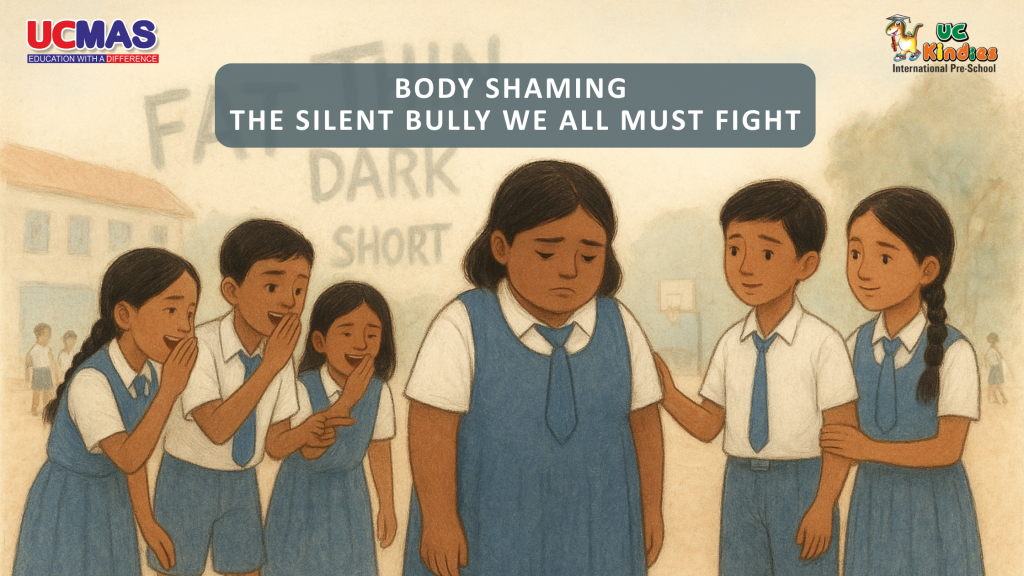Body Shaming: The Silent Bully We All Must Fight
What is Body Shaming? Body shaming occurs when someone criticizes or mocks another person’s appearance based on their weight, shape, size, or other physical characteristics. This can involve name-calling, teasing, or making negative comments. It’s different from light teasing or joking around with friends. It’s hurtful and often meant to shame someone for their appearance Body shaming is a form of bullying, and it has become increasingly common among school children, both online and in person. Body shaming is everywhere. It shows up on social media, in conversations, and even in the way people are treated. It manifests in various ways, such as: Insults: Directly insulting someone by calling them “fat,” “short,” or comparing them to animals. Even nonverbal actions such as staring, ignoring, or making rude gestures communicate disapproval without words. Commenting on Eating Habits: Judging someone for eating more, less, or differently than others. Joking About Weight: Making jokes or embarrassing remarks that single out the victim, making them feel like an outsider or a target of ridicule. Referencing Skin color: Different climate and parents’ genes are factors that are not in a child’s control, but being too dark-skinned or too fair is often targeted for bullying. The impact of body shaming can be profound and long-lasting, particularly for young children. Early experiences of body scrutiny in school may lead to feelings of shame, anxiety, guilt, or even depression. This harmful behaviour can deeply upset someone’s mental health, crush their confidence, and make their social life difficult. Body shaming isn’t just about words; it leaves scars that last. Addressing this issue is essential for creating a world where everyone feels safe and accepted. Why is Body Shaming increasing among School Children? Body shaming often stems from societal pressures, particularly the idealized beauty standards pushed by media & advertising. These ever-changing standards are only promoting the beauty industry and their interests, presenting a narrow definition of beauty that isn’t realistic. Certain cultural norms add to this. Whether it’s body weight, complexion, or height, there is a perceived notion of the ideal body image, which many are chasing. It leads to many children feeling vulnerable to bullying as they think less of themselves. Children who are deemed “too short” or “too tall” can become targets of body shaming, regardless of where they fall on the spectrum. Everyone is a victim of body shaming in one way or another. Body shaming has a Direct impact on Academic Performance. Children may skip school to avoid teasing or lack the confidence to engage in class, creating a cycle that stunts their overall growth. Teaching people early about body diversity is key. Schools can include lessons about self-esteem and acceptance. Body shaming has Psychological and Emotional Effects on Children Self-Esteem and Body Image – Body shaming shakes children’s confidence, leading them to view themselves negatively. This damaged self-worth can foster feelings of shame or worthlessness. Anxiety, Depression, and Other Mental Health Concerns – Frequent teasing can lead to persistent worry, sadness, or anxiety. In some cases, children may develop depression or other mental health challenges as a result of ongoing body shaming. Long-Term Psychological Impact The effects of body shaming can persist into adulthood. Some children may develop eating disorders, such as anorexia or bulimia, as a response to body shame. The Normalization of Body Shaming Body shaming is increasingly prevalent in schools, reflecting a broader lack of empathy among young people. This insensitivity risks raising a generation of individuals who are less compassionate and understanding. What is Empathy, and Why is it Important? Empathy is the ability to understand and share another person’s feelings. Teaching children empathy creates stronger relationships, better conflict resolution, and a deeper understanding of the world. Empathetic children are more likely to treat others with kindness and respect, reducing behaviors like body shaming. A Note to Parents Children learn by observing the adults around them. Comments like, “You’ve lost weight! Aren’t you eating?” or “Your child looks plump—you should feed them less” are often seen as casual conversation starters. However, these remarks normalize commenting on others’ appearances, inadvertently teaching children that such behaviour is acceptable. Parents must model empathy and avoid making uninvited comments about others’ bodies. The Role of Parental Involvement Parents play a critical role in countering body shaming. Open discussions about body image and reinforcing positive messages at home can help children build resilience and confidence. Encouraging self-acceptance and celebrating individuality equips children to navigate societal pressures. Help your child promote a positive body image by: Together, let’s create a culture of Kindness Every child deserves to be valued for who they are. Let’s work together to make this a reality in every school community. We all have a role in fighting this behaviour. By raising awareness, promoting kindness, and speaking out, we can make a difference. Let’s commit to accepting everybody and creating a world where everyone can feel confident and loved. Reducing body shaming leads to more kindness, respect, and a better society for all.
Body Shaming: The Silent Bully We All Must Fight Read More »


